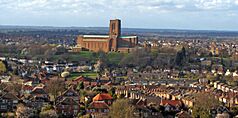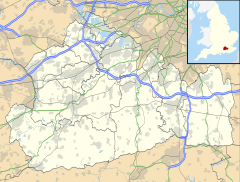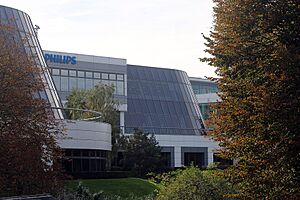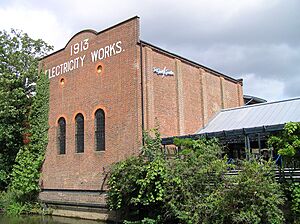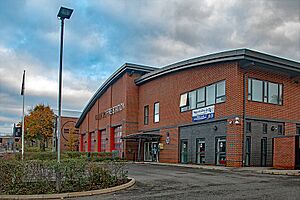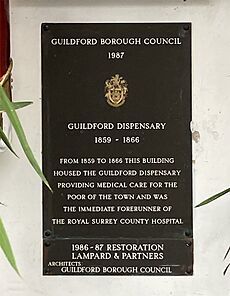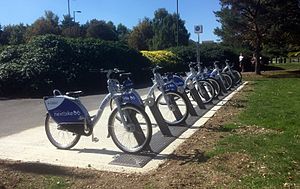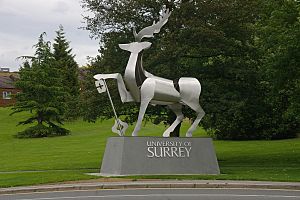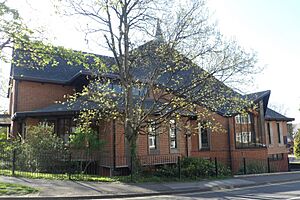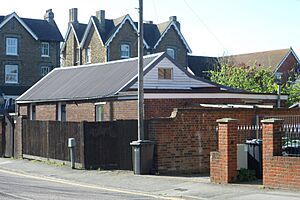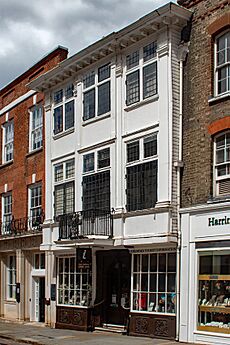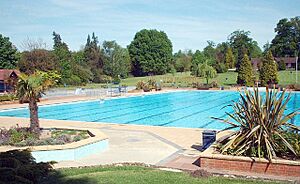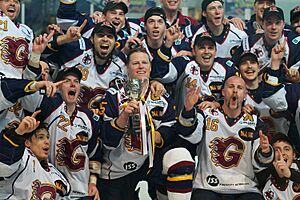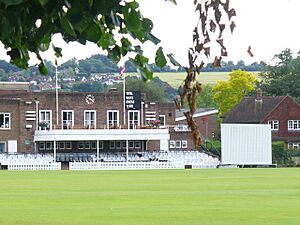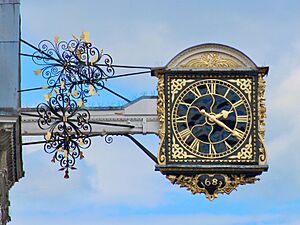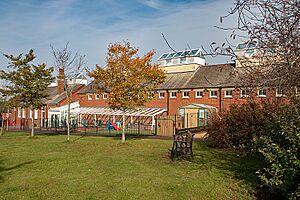Guildford facts for kids
Quick facts for kids Guildford |
|
|---|---|
| Town | |
|
Clockwise from top left: Guildford railway station; Quarry Street; Guildford Cathedral with residential housing in the foreground; the Guildhall; and the Electric Theatre by the River Wey |
|
| Population | 77,057 (2011) |
| OS grid reference | SU9949 |
| • London | 27.5 miles (44.3 km) NE |
| District |
|
| Shire county | |
| Region | |
| Country | England |
| Sovereign state | United Kingdom |
| Post town | Guildford |
| Postcode district | GU1-4 |
| Dialling code | 01483 |
| Police | Surrey |
| Fire | Surrey |
| Ambulance | South East Coast |
| EU Parliament | South East England |
| UK Parliament |
|
Guildford (![]() i/ˈɡɪlfərd/) is a historic town in Surrey, England. It is located about 27 miles (43 km) southwest of central London. In 2011, about 77,000 people lived in Guildford. The town is built around a crossing point on the River Wey. This river flows through the town centre and eventually joins the River Thames.
i/ˈɡɪlfərd/) is a historic town in Surrey, England. It is located about 27 miles (43 km) southwest of central London. In 2011, about 77,000 people lived in Guildford. The town is built around a crossing point on the River Wey. This river flows through the town centre and eventually joins the River Thames.
People have lived in the Guildford area since the Stone Age. The town is even mentioned in the will of Alfred the Great from around 880 AD. After the Normans conquered England, they built a castle here. Later, Guildford became important for trading wool. It received a special charter from King Henry VII in 1488.
The River Wey Navigation opened in 1653. This allowed goods to be easily transported to London by boat. When railways arrived in the 1840s, Guildford grew even more. In 1927, it became the centre of a new Anglican diocese, and Guildford Cathedral was started. In 1966, the University of Surrey was founded, making Guildford a university town.
Today, Guildford is surrounded by the beautiful Surrey Hills National Landscape. This limits how much the town can grow to the east, west, and south. Most new buildings are now in the north, towards Woking. Guildford is considered the southwestern edge of the Greater London Built-up Area.
Contents
- Understanding Guildford's Name
- A Look Back at Guildford's Past
- Where is Guildford?
- Who Lives in Guildford?
- Businesses in Guildford
- Public Services in Guildford
- Getting Around Guildford
- Learning in Guildford
- Places of Worship
- Culture and Arts
- Sports in Guildford
- Famous Buildings and Landmarks
- Parks and Green Spaces
- Famous People from Guildford
- Images for kids
- See also
Understanding Guildford's Name
The name "Guildford" has a long history. The oldest record, from around 1000 AD, calls it Gyldeforda. Later, it was known as Gildeford and Guldeford.
What Does "Guildford" Mean?
The first part of the name, gylde, might come from an Old English word for "gold." This could refer to the golden colour of the sand south of the town. It might also mean the yellow flowers, like marigolds, that grew near the river. The second part, ford, means a shallow place where you can cross a river. So, Guildford likely means "golden ford."
Some historians thought "Guild" referred to a group of tradesmen. However, the older spellings suggest "gold" is more likely. There's even an old inn called "Sanford Arms," which might mean "Sand Ford." This supports the idea that the name comes from the golden sand near the River Wey.
A Look Back at Guildford's Past
Guildford has a rich history, from ancient times to modern days.
Early Settlements and Roman Times
Some stories connect Guildford to King Arthur's legendary city of Astolat. However, only older Celtic and Bronze Age items have been found here. Some tiles in Guildford Castle might be Roman. A Roman villa was also found nearby on Broad Street Common.
Saxon and Norman Guildford
Archaeology shows that Saxon settlers built Guildford as a small town. It likely grew because the Harrow Way, an ancient path, crossed the River Wey here.
Alfred the Great, the first king of a united England, mentioned Guildford in his will. The town even had a Royal Mint (where coins were made) from 978 AD until the time of William the Conqueror.
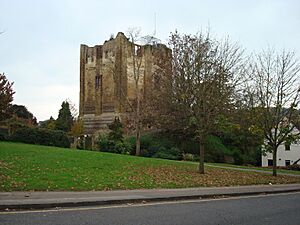
After the Norman Conquest, a castle was built in Guildford. This Guildford Castle was designed in the Norman style. It was placed to control the important Pilgrims' Way and the river crossing. This made it a key military spot.
The Domesday Book of 1086 lists Guildford as Geldeford or Gildeford. It was owned by William the Conqueror. The town had 75 houses and 175 families. The castle was later used as a royal hunting lodge. Kings like King John and King Henry III visited it often. The castle was restored in Victorian times and again in 2004. Its grounds are now a public garden.
In 1995, a special room was found in the High Street. It is believed to be the remains of a 12th-century Guildford Synagogue. If true, it would be the oldest surviving synagogue in Western Europe.
Guildford became a successful town from the 14th to the 18th centuries, thanks to the wool trade. The Guildhall was built in the 14th century. Its famous clock was added in 1683 and can still be seen today.
From Renaissance to Industrial Growth
The Royal Grammar School was built in 1509. It became "Royal" in 1552 under King Edward VI. In the 1550s, a student named John Derrick attended the school. In 1597, he made a legal statement that is the earliest known mention of cricket being played anywhere in the world. He said he played "Creckett" as a child in Guildford around 1550.
In 1619, George Abbot founded the Hospital of the Holy Trinity, also known as Abbot's Hospital. This beautiful building provided homes for people in need. It is located at the top of the High Street.
A big boost for Guildford came in 1653 with the completion of the Wey Navigation. This canal allowed businesses to transport goods by boat to the River Thames in Weybridge. This happened more than a century before most other canals in Britain were built. Later, the navigation was extended to Godalming and even connected to the sea.
Guildford in Modern Times
The railway arrived in Guildford in 1845, connecting it to Woking and London. More railway lines followed, linking Guildford to other towns like Godalming and Reading.
From 1820 to 1865, Guildford saw some serious public disorder known as the "Guy Riots." Groups of people, called "Guys," would cause trouble on Guy Fawkes Night. They would wear masks, carry clubs and torches, and damage property. Police tried to stop them, and two officers even died. Eventually, soldiers were called in, and the riots ended by 1868.
In 1885, the Gates brothers, who ran a wine and beer shop, decided to join the temperance movement. They poured all their alcohol into the street! They then started a dairy business. This company grew and became Cow & Gate, famous for baby formula.
During World War II, Guildford built 18 public air raid shelters. One of these, the Foxenden Quarry deep shelter, was built into a disused chalk quarry. It could hold 1000 people and had facilities for them. This shelter is still preserved and opens to the public once a year.
In 1974, bombs were set off in two pubs in Guildford. This tragic event killed five people. The people arrested for the bombings, known as the Guildford Four, were later found to be innocent and released from prison in 1989.
Where is Guildford?
 |
Worplesdon | across part of Worplesdon Woking |
across Burpham Send |
 |
| Flexford, Wanborough | across Merrow West Clandon |
|||
| across Loseley ParkComptonacross ArtingtonGodalming | Shalford | Chilworth |
Guildford is located in west Surrey. It has several neighbouring towns and villages. To the north are Woking and Send. To the west are Normandy and Wanborough. To the east are Merrow and West Clandon. To the south are Godalming, Shalford, and Chilworth.
Who Lives in Guildford?
In the 2011 census, Guildford had a population of 79,185 people. Most residents (87.3%) were white. About 7.1% were of Asian descent, and 2.2% were of mixed race.
| Area | Population | Households | Owned outright | Owned with a loan | Social rented | Private rented |
|---|---|---|---|---|---|---|
| Guildford | 79,185 | 31,328 | 29.5% | 33.6% | 14.4% | 19.6% |
| South East Region | 8,634,750 | 3,555,463 | 35.1% | 32.5% | 13.7% | 16.3% |
| Area | Detached | Semi-detached | Terraced | Flats and apartments |
|---|---|---|---|---|
| Guildford | 25.9% | 33.3% | 14.2% | 26.7% |
| South East Region | 28.0% | 27.6% | 22.4% | 21.2% |
Businesses in Guildford
Guildford is home to many important businesses. In 2011, major companies like Philips, Ericsson, Colgate-Palmolive, Allianz, and Sanofi had a strong presence in the town.
Guildford is also a big centre for making video games. Companies like Media Molecule, Lionhead Studios, Hello Games, Criterion Games, Ghost Games, and Bullfrog Productions are based here. The electronic parts company, discoverIE Group, is located at the Surrey Research Park. Military vehicle builders Automotive Technik also have a factory in Guildford.
Public Services in Guildford
Guildford has many services to help its residents.
Utilities: Water, Gas, and Electricity
For a long time, people in Guildford got their water from wells or the River Wey. In 1701, a system was built to pump river water to a reservoir. Later, a new well was dug, but it caused a typhoid fever outbreak due to pollution. By 1898, Guildford had a good water pipe system.
The town's sewage system was built between 1889 and 1895. The current sewage works will be moved to a new site by 2026. This will free up land for new homes.
The first gasworks in Guildford opened in 1824, bringing street lighting to the town. The gasworks closed in the late 1960s. Today, the site is home to the Odeon Cinema.
Electricity generation started in Guildford in 1896. A new power plant opened in 1928. In 1948, the electricity industry became nationalised. The power station closed in 1968. Guildford also has small-scale renewable energy projects. A hydroelectric project on the River Wey, at the former Town Mill, opened in 2006. It uses the river's power to generate electricity.
Emergency Services and Justice
Guildford's first police force was set up in 1836. It had nine officers. In 1941, the Guildford police merged with the Surrey Constabulary. Today, Surrey Police is the local force, with a station on Margaret Road.
The Guildford Fire Brigade started in 1863 as volunteers. It merged with other Surrey brigades in 1947. Today, Guildford Fire Station is on Ladymead.
Ambulance services were provided by St John Ambulance until 1966. Now, the South East Coast Ambulance Service runs local ambulance services from a station on London Road.
Healthcare in Guildford
The first medical centre, the Guildford Dispensary, opened in 1860. It gave free care to the poor. It closed in 1866 when the Royal Surrey County Hospital opened on Farnham Road. This hospital was built as a memorial to Prince Albert. It became part of the NHS in 1948. Today, it is a specialist mental health hospital.
The Guildford Infirmary was built in 1896. It later became St Luke's Hospital and joined the NHS in 1948. It closed as a general hospital in 1980.
The current Royal Surrey County Hospital at Park Barn opened in 1980. It has an Accident and Emergency Department and is the main hospital for Guildford.
Getting Around Guildford
Guildford has good transport links for buses, trains, and even boats.
Buses in Guildford
Buses connect Guildford to nearby towns and villages. The main bus station is the Friary bus station. Many companies operate services, including Stagecoach South. There are also four park & ride car parks around Guildford, with buses going to the town centre. A special coach service, RailAir, runs from the railway station to Heathrow Airport. You can also take a National Express coach to London or Portsmouth.
Trains in Guildford
Guildford railway station is northwest of the town centre. South Western Railway runs most services from here. You can travel to London Waterloo, Portsmouth Harbour, and Alton. Great Western Railway runs services to Gatwick Airport and Reading.
London Road station, northeast of the town centre, also has trains to London Waterloo.
River Travel
The River Wey is navigable from Weybridge to Godalming. The National Trust manages this waterway.
Cycling and Walking
National Cycle Network Route 22 (London to Portsmouth) and Route 223 (Chertsey to Shoreham-by-Sea) pass through Guildford. A bike-sharing scheme started at the University of Surrey in 2018.
Long-distance walking paths also go through Guildford. The North Downs Way passes south of the town centre. The E2 European long distance path follows the River Wey. The Fox Way is a 39-mile (63 km) footpath that circles the town.
Learning in Guildford
Guildford has many schools and a university.
State Schools
Primary schools include Holy Trinity, Burpham, St Thomas of Canterbury, Sandfield Primary, Boxgrove Primary, and Guildford Grove Primary. Junior schools include Bushy Hill, Northmead Junior, and Queen Eleanor's C of E. Secondary schools are George Abbot, Guildford County School, St Peter's, King's College, and Christ's College.
Independent Schools
The Royal Grammar School was founded in 1509. Its old building has a chained library. The Royal Grammar preparatory school is also the choir school for Guildford Cathedral. Other independent schools include Guildford High School, Tormead School, Priors Field School, and Rydes Hill Preparatory School.
Higher Education
The University of Surrey is located in Guildford. It moved here in 1966 and gained its Royal Charter. Guildford is also home to the first campus of the University of Law and the Guildford School of Acting. Other places for learning include Guildford College, the Academy of Contemporary Music, and the Italia Conti Arts Centre.
Places of Worship
Guildford has many churches and other places of worship.
Anglican Churches
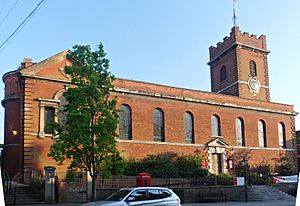
The Church of England churches in Guildford are part of the Guildford Deanery. St Mary's Church on Quarry Street is the oldest, with parts built before the Norman Conquest. Holy Trinity Church on the High Street was rebuilt between 1749 and 1763. St Nicolas Church was also rebuilt in the 1870s. Other Anglican churches include St John the Evangelist at Stoke-next-Guildford, Christ Church, and St Saviour.
Other Christian Churches
There are three Roman Catholic churches: St Joseph's, St Mary's, and St Pius X. The Catholic Parish also includes the Church of St Edmund the Confessor. Guildford also has United Reformed Churches, Baptist Churches, Methodist Churches, the Salvation Army, and several independent churches.
Quaker Meeting House
The first Quaker meetings in Guildford were in 1668. The current meeting house, in Ward Street, was built in 1804-8.
Jewish Synagogues
A 12th-century chamber found in the High Street is thought to be the remains of an old Guildford Synagogue. The modern synagogue on York Road opened in 1978.
Culture and Arts
Guildford has a lively cultural scene with galleries, theatres, and music.
Guildford House Gallery on the High Street shows art about Guildford and by local artists like John Russell.
Guildford is linked to King Arthur's stories and to Alice's Adventures in Wonderland by Lewis Carroll. There are sculptures of Alice in the Castle Grounds and by the River Wey. In The Hitchhiker's Guide to the Galaxy, a character claims to be from Guildford.
The town's main theatre is the Yvonne Arnaud Theatre. The Electric Theatre opened in 1997 for music and drama. The Guildford Shakespeare Company performs in the castle grounds and local churches.
Guildford has an Odeon cinema. G Live is a modern arts and entertainment venue that opened in 2011. The Guildford Philharmonic Orchestra used to be fully funded by the council but was disbanded in 2013.
Stoke Park, Guildford's largest park, hosts the GuilFest music festival. The Astolat Model Railway Circle also has an annual exhibition here.
Local Media
Radio stations like Kane 103.7 FM, Greatest Hits Radio Surrey & East Hampshire, GU2 Radio, and BBC Radio Surrey are based in Guildford. The Surrey Advertiser is the local newspaper, and The Guildford Dragon NEWS is an independent online newspaper.
Sports in Guildford
Guildford offers many sports facilities and teams.
Sports Venues
The Spectrum Leisure Centre opened in 1993. It has four swimming pools, an Olympic-sized ice rink, and a ten-pin bowling alley.
Guildford Lido, also in Stoke Park, is a large outdoor heated swimming pool. It opened in 1933.
The Surrey Sports Park, owned by the University of Surrey, opened in 2010. It has a 50-metre swimming pool, a climbing wall, squash courts, and sports pitches.
Professional Sports Teams
The Guildford Flames ice hockey team plays at the Spectrum Leisure Centre. They have won the English Premier League four times.
The Surrey Scorchers are a professional basketball club. The Surrey Storm Netball team is also based at the Surrey Sports Park.
Cricket in Guildford
Cricket is believed to have started in southeast England. The first written record of cricket is from a Guildford resident, John Derrick. In 1597, he said he played "Creckett" as a child in Guildford around 1550.
Guildford Cricket Club was founded in 1866. They play at the Woodbridge Road ground, where Surrey County Cricket Club also plays some matches. Famous players like Ashley Giles and Ollie Pope have played here.
Other Sports
Guildford City Football Club was founded in 1996. Guildford International Volleyball Club has won the fourth division of the National Volleyball League.
There are several field hockey clubs in the area, including Guildford Hockey Club. Charlotteville Cycling Club, founded in 1903, promotes cycle races on the High Street. Guildford City Boxing Club is one of the oldest in Surrey. The Guildford Crows Aussie Rules FC plays Australian Rules Football. Guildford Rowing Club has won at the Henley Women's Regatta.
Famous Buildings and Landmarks
Guildford has many interesting old buildings.
Abbot's Hospital
Abbot's Hospital was founded in 1622 by George Abbot, the Archbishop of Canterbury. It provided homes for single people from Guildford. The building is made of dark red brick and has a central courtyard. The chapel inside still has its original wooden seating.
Dapdune Wharf
Dapdune Wharf has been the main boatyard for the River Wey Navigation since 1653. The National Trust offers boat trips from here. There is also a visitor centre.
Guildford Institute
The Guildford Institute was founded in 1834 to promote learning. Its current building opened in 1892. Today, it offers courses, a library, and a restaurant. It aims to be a cultural and social hub for the community.
Guildford Museum

The Guildford Museum was founded in 1898. It is located in Castle Arch House, which includes parts of the 13th-century castle gateway. The museum officially opened in 1907. It has collections of archaeological finds, textiles, and items showing the town's history.
The Guildhall
The Guildford Guildhall was built around 1550. The council chamber and the front of the building were added in 1683. The famous clock case also dates from this year. The Guildhall is a well-known landmark on the High Street.
The Spike
The building known as The Spike was built in 1906. It was a "Casuals Ward" for the Guildford Union Workhouse. It housed homeless people who had to do hard labour. Four of the original stone-breaking cells still exist. Since 2008, The Spike has been a community and heritage centre.
The Undercroft
The Undercroft is a medieval cellar located beneath 72–74 High Street. It is one of six cellars from the late Middle Ages that still exist in the town centre. It is open to the public twice a week.
Parks and Green Spaces
Guildford has several lovely parks and open areas.
Stoke Park
Stoke Park is a large park next to the town centre. It has sports facilities and play areas. Lord Onslow donated it to the town in 1925.
Allen House Grounds
Allen House was built in the 17th century. The house and its grounds were given to the Royal Grammar School in 1914. The house was later taken down, but the grounds are now a public park. They include a garden inspired by Lewis Carroll's poem Jabberwocky.
Pewley Down
Pewley Down is a Local Nature Reserve on a hill southeast of the town. This area of chalk grassland is home to many types of orchids and butterflies.
Famous People from Guildford
Many notable people have connections to Guildford.
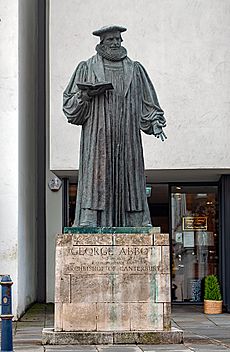
- George Abbot (1562–1633) was the Archbishop of Canterbury. He was born in Guildford and founded Abbot's Hospital.
- John Russell (1745–1806) was a famous portrait artist. He was born and lived in Guildford until he was 15.
- Thomas Moore (1821–1887) was a botanist born in Stoke-next-Guildford.
- Lewis Carroll (1832–1898), the author of Alice's Adventures in Wonderland, died in Guildford at his sisters' home. He visited them every Christmas.
- Edward Carpenter (1844–1934), a poet and philosopher, lived in Guildford after World War I.
- Roger Fry (1866–1934), an artist and art critic, lived in Guildford from 1909 to 1919.
- Mildred Cable (1878–1952) was a Protestant missionary born in Guildford.
- Leonard Colebrook (1883–1967) was a bacteriologist born in Guildford.
- Alan Turing (1912–1954), a famous mathematician and computer scientist, stayed in Guildford during school holidays.
- Stuart Wilson (born 1946) is an actor born in Guildford.
- Mike Rutherford (born 1950), a musician, was born in Guildford.
- Kazuo Ishiguro (born 1954), a novelist, lived in Guildford as a child.
Images for kids
See also
 In Spanish: Guildford para niños
In Spanish: Guildford para niños




